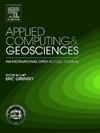GPE-DNeRF:地表地质体重建的神经辐射场方法
IF 3.2
Q2 COMPUTER SCIENCE, INTERDISCIPLINARY APPLICATIONS
引用次数: 0
摘要
三维(3D)地质模型对于全面了解区域地质构造至关重要。基于深度学习的三维重建技术为识别复杂的数据模式和生成真实的重建结果提供了高度自动化的方法。这些方法在地表地质体重建中的应用,在全国推进数字矿山建设的背景下显得尤为重要。神经辐射场(NeRF)已被用于生成3D场景的训练模型从不同的视点捕获的图像。然而,视差误差可能导致生成图像中的细节不对齐或重叠,特别是在具有复杂几何结构的区域。这些误差会阻碍模型准确重建表面细节的能力,导致最终输出的大量扭曲。为了解决这一问题,减少重建的三维地表地质模型中的伪影和噪声,本研究探索了使用NeRF进行地质体重建。本文提出了一种改进的GPE-DNeRF方法,该方法将深度信息与高斯位置编码相结合,实现了高质量的地质表面重建。对该方法的性能进行了评价,并与SfM-MVS和NeRF方法进行了比较分析。GPE-DNeRF方法显示出强大的消除伪影和保留详细地形特征的能力,从而提高了重建质量,并确保与实际地表地质条件更接近。本文章由计算机程序翻译,如有差异,请以英文原文为准。
GPE-DNeRF:Neural radiance field method for surface geological bodies reconstruction
Three-dimensional (3D) geological models are crucial for a comprehensive understanding of regional geological formations. Deep learning-based 3D reconstruction technologies offer highly automated approaches for recognizing complex data patterns and generating realistic reconstruction results. The application of these methods in the reconstruction of surface geological bodies is particularly significant in the context of advancing the construction of digital mines nationwide. Neural Radiance Fields (NeRF) have been employed to generate 3D scenes by training models on images captured from different viewpoints. However, parallax errors across viewpoints may lead to misalignment or overlapping of details in the generated images, especially in regions with complex geometric structures. These errors can hinder the model's ability to accurately reconstruct surface details, resulting in substantial distortions in the final output. To address this issue and reduce artifacts and noise in the reconstructed 3D surface geological model, this study explores the use of NeRF for geologic body reconstruction. We propose an enhanced method, GPE-DNeRF, which integrates depth information with Gaussian positional encoding to achieve high-quality reconstruction of geological surfaces. The performance of the proposed method is evaluated, and comparative analyses are conducted with the SfM-MVS and NeRF methods. The GPE-DNeRF method demonstrates a strong capability to eliminate artifacts and retain detailed terrain features, thereby enhancing reconstruction quality and ensuring a closer alignment with actual surface geological conditions.
求助全文
通过发布文献求助,成功后即可免费获取论文全文。
去求助
来源期刊

Applied Computing and Geosciences
Computer Science-General Computer Science
CiteScore
5.50
自引率
0.00%
发文量
23
审稿时长
5 weeks
 求助内容:
求助内容: 应助结果提醒方式:
应助结果提醒方式:


